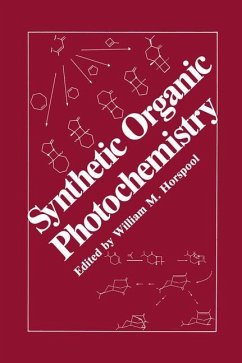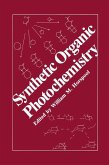Synthetic Organic Photochemistry
Herausgegeben von Horspool, W.M.
Synthetic Organic Photochemistry
Herausgegeben von Horspool, W.M.
- Broschiertes Buch
- Merkliste
- Auf die Merkliste
- Bewerten Bewerten
- Teilen
- Produkt teilen
- Produkterinnerung
- Produkterinnerung
Of all major branches of organic chemistry, I think none has undergone such a rapid, even explosive, development during the past twenty-five years as organic photochemistry. Prior to about 1960, photochemistry was still widely regarded as a branch of physical chemistry which might perhaps have oc casional applications in the generation of free radicals. Strangely enough, this attitude to the subject had developed despite such early signs of promise as the photodimerization of anthracene first observed by Fritzsche in 1866, and some strikingly original pioneering work by Ciamician and Silber in…mehr
Andere Kunden interessierten sich auch für
![Synthetic Organic Photochemistry Synthetic Organic Photochemistry]() W.M. Horspool (ed.)Synthetic Organic Photochemistry231,99 €
W.M. Horspool (ed.)Synthetic Organic Photochemistry231,99 €![Organic Syntheses by Oxidation with Metal Compounds Organic Syntheses by Oxidation with Metal Compounds]() Organic Syntheses by Oxidation with Metal Compounds109,99 €
Organic Syntheses by Oxidation with Metal Compounds109,99 €![Preparative Organic Photochemistry Preparative Organic Photochemistry]() P. MargarethaPreparative Organic Photochemistry77,99 €
P. MargarethaPreparative Organic Photochemistry77,99 €![Synthetic Organic Sonochemistry Synthetic Organic Sonochemistry]() Jean-Louis LucheSynthetic Organic Sonochemistry116,99 €
Jean-Louis LucheSynthetic Organic Sonochemistry116,99 €![Elements of Organic Photochemistry Elements of Organic Photochemistry]() Elements of Organic Photochemistry77,99 €
Elements of Organic Photochemistry77,99 €![Computational Modeling of Homogeneous Catalysis Computational Modeling of Homogeneous Catalysis]() Computational Modeling of Homogeneous Catalysis116,99 €
Computational Modeling of Homogeneous Catalysis116,99 €![Preparative Polar Organometallic Chemistry Preparative Polar Organometallic Chemistry]() Lambert BrandsmaPreparative Polar Organometallic Chemistry38,99 €
Lambert BrandsmaPreparative Polar Organometallic Chemistry38,99 €-
-
-
Of all major branches of organic chemistry, I think none has undergone such a rapid, even explosive, development during the past twenty-five years as organic photochemistry. Prior to about 1960, photochemistry was still widely regarded as a branch of physical chemistry which might perhaps have oc casional applications in the generation of free radicals. Strangely enough, this attitude to the subject had developed despite such early signs of promise as the photodimerization of anthracene first observed by Fritzsche in 1866, and some strikingly original pioneering work by Ciamician and Silber in the early years of this century. These latter workers first reported such varied photo reactions as the photoisomerization of carvenone to carvone camphor, the photodimerization of stilbene, and the photoisomerization of o-nitrobenzal dehyde to o-nitrosobenzoic acid; yet organic chemists continued for another fifty years or so to rely almost wholly on thermal rather than photochemical methods of activation in organic synthesis-truly a dark age. When my colleagues and I first began in the 1950s to study the synthetic possibilities of photoexcitation in the chemistry of benzene and its derivatives, virtually all the prior reports had indicated that benzene was stable to ultraviolet radiation. Yet I think it fair to say that more different types of photoreactions than thermal reactions of the benzene ring are now known. Comparable growth of knowledge has occurred in other branches of organic photochemistry, and photochemical techniques have in particular made possible or simplified the synthesis of numerous highly strained organic molecules.
Produktdetails
- Produktdetails
- Verlag: Springer / Springer US / Springer, Berlin
- Artikelnr. des Verlages: 978-1-4612-9668-3
- 1984
- Seitenzahl: 556
- Erscheinungstermin: 4. Oktober 2011
- Englisch
- Abmessung: 229mm x 152mm x 30mm
- Gewicht: 794g
- ISBN-13: 9781461296683
- ISBN-10: 1461296684
- Artikelnr.: 40734695
- Verlag: Springer / Springer US / Springer, Berlin
- Artikelnr. des Verlages: 978-1-4612-9668-3
- 1984
- Seitenzahl: 556
- Erscheinungstermin: 4. Oktober 2011
- Englisch
- Abmessung: 229mm x 152mm x 30mm
- Gewicht: 794g
- ISBN-13: 9781461296683
- ISBN-10: 1461296684
- Artikelnr.: 40734695
1. Photoaddition and Photocyclization Processes of Aromatic Compounds.- 1. Introduction.- 2. Intermolecular Reactions.- 2.1. Arenes and Ethenes.- 2.2. Arenes and Acetylenes.- 2.3. Arenes and 1,3-Dienes.- 2.4. Acyclic Additions to Arenes and Reduction Processes.- 2.5. Arene Photodimerizations.- 3. Intramolecular Cyclization Processes.- 3.1. Arene-Ethene and Arene-Ethyne Systems.- 3.1.1. Hydrocarbon Systems.- 3.1.2. Aryl Enones.- 3.1.3. Aryl Ethenyl Ethers, Thioethers, and N- Aryl Enamines.- 3.1.4. Cyclizations of N-Arylanilides and N-Benzoylenamines.- 3.2. Aryl Butadiene and Butenyne Systems.- 3.3. Intramolecular Photocoupling of Arenes.- 3.3.1. Stilbene-Phenanthrene-Type Cyclizations.- 3.3.2. Photocoupling of Arenes with Intervening Units Other Than Ethylene.- 3.3.3. Coupling of Arenes as a Result of Halogen Acid Photoelimination.- 3.4. Photocyclizations of o-Substituted Arenes.- References.- 2. Enone Photochemical Cycloaddition in Organic Synthesis.- 1. Introduction.- 2. The Reaction Mechanism.- 3. Regiochemistry of Enone Cycloaddition.- 4. Stereochemistry of Enone Cycloaddition.- 5. Intramolecular Enone Cycloadditions.- 6. The de Mayo Reaction.- 6.1. Cyclic Diketones.- 6.2. Acyclic 1,3-Diketones.- 6.3. Intramolecular Additions of Enolized Diketones.- 7. Intermolecular Enone Cycloaddition.- 8. Photochemical Cycloaddition between Enones and Allenes.- References.- 3. Synthetic Aspects of Photochemical Electron Transfer Reactions.- 1. Introduction.- 1.1. Synthetic Applications of Photochemical Reactions.- 1.2. Electron Transfer in Excited-State Chemistry.- 1.2.1. Exciplex Formation and Decay.- 1.2.2. Electron Transfer Efficiencies and Rates.- 1.3. Chemical Consequence of Electron Transfer.- 1.3.1. General Survey and Predictions.- 1.3.2. Overview of Coverage.- 2. Reaction Pathways Followed in Electron Transfer Photochemistry.- 2.1. Alkenes and Strained Ring Hydrocarbons.- 2.1.1. Alkenes as Electron Acceptors and Donors.- 2.1.2. Cyclopropene Electron Transfer Photochemistry.- 2.1.3. Cyclopropanes and Other Strained Ring Systems as Electron Donors.- 2.2. Amines.- 2.2.1. General Considerations.- 2.2.2. Amine-Olefin Electron Transfer Photochemistry.- 2.2.3. Amine-Ketone Electron Transfer Photochemistry.- 2.3. Ketones.- 2.3.1. General Considerations.- 2.3.2. Ketone Electron Transfer Photochemistry.- 2.3.3. Quinone Electron Transfer Photochemistry.- 2.4. Electron Transfer Photooxygenations.- 2.4.1. General Considerations.- 2.4.2. Class 1 Photooxygenations.- 2.4.3. Class 2 Photooxygenations.- 2.4.4. Class 3 Photooxygenations.- 2.5. Aromatic Systems.- 2.5.1. Aromatic Photosubstitution Reactions.- 2.5.2. Photobenzylations by Electron Transfer Mechanisms.- 2.5.3. Birch and Related Photoreductions of Aromatic Compounds.- 2.6. Electron Transfer Photochemistry of Nitrogen Heteroaromatic Salts and Related Systems.- 2.6.1. General Considerations.- 2.6.2. Electron Transfer Photochemistry of Pyridinium and Related Salts.- 2.6.3. Iminium Salt Photochemistry.- 2.7. Other Electron Transfer Initiated Photoreactions.- 2.7.1. Olefin Cycloadditions and Retro Processes.- 2.7.2. Phthalimide Photochemistry.- 2.7.3. Photodecarboxylations.- 2.7.4. Metal Catalyzed Photoreactions.- References.- 4. Phthalimide and Its Derivatives.- 1. Introduction.- 2. Hydrogen Abstraction.- 2.1. Photoreduction and Photoaddition.- 2.2. Intramolecular Photocyclization.- 3. Reaction with Alkenes.- 3.1. Ring Expansion.- 3.2. Solvent Incorporation.- 3.3. Intramolecular Reaction.- 4. Cleavage Reactions.- 4.1. ?-Cleavage.- 4.2. ?-Cleavage.- 5. Spectra and Excited States.- 6. Summary.- References.- 5. Photochemical Addition Reactions in the Benzo(b)Thiophene, Benzo(b)Furan, and Indole Series.- 1. Introduction.- 1.1. Absorption and Emission Characteristics.- 2. Photochemistry.- 2.1. Oxetan Formation.- 2.2. Dimerization.- 2.3. Photochemical Reactions with Acetylene Esters.- 3. Benzo(b)thiophene.- 4. Indoles.- 5. Benzo(b)thiophenes.- 6. Benzo(b)furans.- 7. Thermal Reactions of the 2-Hetero-bicyclo(3.2.0)heptadienes.- 8. 1,3-Dimethylindole.- 9. Photocycloadditions of Benzo(b)thiophene to Alkenes.- References.- 6. Azirine Photolysis and Cycloaddition Reactions.- 1. Introduction.- 1.1. UV Spectra of Arylazirines.- 1.1.1. Evidence for Nitrile Ylide Formation.- 2. Cycloaddition Reactions.- 2.1. Addition with Electron-Deficient Olefins.- 2.1.1. Mechanism of Cycloaddition to Olefines.- 2.2. Addition to Aldehydes and Ketones.- 2.3. Addition to Esters.- 2.4. Additions to Acid Chloride and Anhydrides.- 2.5. Additions to Carbon Dioxide and Carbon Disulfide.- 2.6. Additions to Ketenes, Carbodiimides, Isocyanates, and Isothiocyanates.- 3. Photodimerization of Azirines.- 4. Intramolecular Cycloaddition Reactions.- 4.1. Rearrangement of 2-Vinylazirines.- 4.2. Rearrangements of Isoxazoles and Oxazoles.- 5. Mechanisms for Cycloaddition Reactions of Nitrile Ylides.- 5.1. The 1,1-Cycloaddition Process.- 5.2. Summary of 1,1-Cycloaddition Mode.- 5.3. Other Examples of 1,1-Cycloaddition.- 5.4. 1,1- and 1,3-Cycloaddition in Competition.- 6. Fragmentation Reactions.- 6.1. Competitive Involvement of Ylide Formation.- 7. Group Migration Reactions.- References.- 7. Photoremovable Protecting Groups.- 1. Introduction.- 2. Alcohols.- 2.1. Sulfonic Acid Esters.- 2.2. o-Nitrobenzyl Ethers.- 2.3. Nitrates, Nitrites, Dimelhylthiocarbamates, and Aryl Azides.- 3. Diols.- 4. Phenols.- 5. Aldehydes and Ketones.- 6. Carboxylic Acids and Amides.- 6.1. o-Nitrobenzyl Esters.- 6.2. o-Nitrophenylamino Derivatives.- 6.3. Phenacyl Esters.- 6.4. 2,4-Dinitrophenylthio Esters, Benzoin Esters, and Aryl Azides.- 7. Amines.- 7.1. Benzyloxycarbonyl Compounds.- 7.2. Sulfonamides.- 7.3. Formamides, N-Oxides, and 4,5-Diaryl-4-oxazoline-2-ones.- 8. Phosphates.- 9. Conclusion.- References.- 8. Photochemical Synthesis of Oxetans.- 1. Introduction.- 2. Reaction Mechanism.- 2.1. Carbonyl Excited States.- 2.2. Triplet Energies.- 2.3. Competing Reactions.- 2.4. Hydrogen Abstraction.- 3. Alkene Addends.- 3.1. Simply Substituted Alkenes.- 3.2. Dienes and Trienes.- 3.3. Allenes and Ketenimines.- 3.4. Electron-Deficient Alkenes.- 3.5. Vinyl Ethers.- 3.6. Heteroaromatics.- 4. Carbonyl Addends.- 4.1. ?-Dicarbonyls.- 4.2. Quinones.- 4.3. Miscellaneous Carbonyls.- 4.4. Enones and Ynones.- 5. Intramolecular Cycloadditions.- 6. Chemical Reactions of Oxetans.- References.- 9. Equipment and Techniques.- 1. Mercury Vapor Lamps.- 2. Lamps in Conjunction with Filters.- 3. Photochemical Apparatus.- 4. Actinometry.- 4.1. Solution Phase Systems.- 4.2. Electronic Actinometers.- 5. Purity of Solvents and Gases.- References.
1. Photoaddition and Photocyclization Processes of Aromatic Compounds.- 1. Introduction.- 2. Intermolecular Reactions.- 2.1. Arenes and Ethenes.- 2.2. Arenes and Acetylenes.- 2.3. Arenes and 1,3-Dienes.- 2.4. Acyclic Additions to Arenes and Reduction Processes.- 2.5. Arene Photodimerizations.- 3. Intramolecular Cyclization Processes.- 3.1. Arene-Ethene and Arene-Ethyne Systems.- 3.1.1. Hydrocarbon Systems.- 3.1.2. Aryl Enones.- 3.1.3. Aryl Ethenyl Ethers, Thioethers, and N- Aryl Enamines.- 3.1.4. Cyclizations of N-Arylanilides and N-Benzoylenamines.- 3.2. Aryl Butadiene and Butenyne Systems.- 3.3. Intramolecular Photocoupling of Arenes.- 3.3.1. Stilbene-Phenanthrene-Type Cyclizations.- 3.3.2. Photocoupling of Arenes with Intervening Units Other Than Ethylene.- 3.3.3. Coupling of Arenes as a Result of Halogen Acid Photoelimination.- 3.4. Photocyclizations of o-Substituted Arenes.- References.- 2. Enone Photochemical Cycloaddition in Organic Synthesis.- 1. Introduction.- 2. The Reaction Mechanism.- 3. Regiochemistry of Enone Cycloaddition.- 4. Stereochemistry of Enone Cycloaddition.- 5. Intramolecular Enone Cycloadditions.- 6. The de Mayo Reaction.- 6.1. Cyclic Diketones.- 6.2. Acyclic 1,3-Diketones.- 6.3. Intramolecular Additions of Enolized Diketones.- 7. Intermolecular Enone Cycloaddition.- 8. Photochemical Cycloaddition between Enones and Allenes.- References.- 3. Synthetic Aspects of Photochemical Electron Transfer Reactions.- 1. Introduction.- 1.1. Synthetic Applications of Photochemical Reactions.- 1.2. Electron Transfer in Excited-State Chemistry.- 1.2.1. Exciplex Formation and Decay.- 1.2.2. Electron Transfer Efficiencies and Rates.- 1.3. Chemical Consequence of Electron Transfer.- 1.3.1. General Survey and Predictions.- 1.3.2. Overview of Coverage.- 2. Reaction Pathways Followed in Electron Transfer Photochemistry.- 2.1. Alkenes and Strained Ring Hydrocarbons.- 2.1.1. Alkenes as Electron Acceptors and Donors.- 2.1.2. Cyclopropene Electron Transfer Photochemistry.- 2.1.3. Cyclopropanes and Other Strained Ring Systems as Electron Donors.- 2.2. Amines.- 2.2.1. General Considerations.- 2.2.2. Amine-Olefin Electron Transfer Photochemistry.- 2.2.3. Amine-Ketone Electron Transfer Photochemistry.- 2.3. Ketones.- 2.3.1. General Considerations.- 2.3.2. Ketone Electron Transfer Photochemistry.- 2.3.3. Quinone Electron Transfer Photochemistry.- 2.4. Electron Transfer Photooxygenations.- 2.4.1. General Considerations.- 2.4.2. Class 1 Photooxygenations.- 2.4.3. Class 2 Photooxygenations.- 2.4.4. Class 3 Photooxygenations.- 2.5. Aromatic Systems.- 2.5.1. Aromatic Photosubstitution Reactions.- 2.5.2. Photobenzylations by Electron Transfer Mechanisms.- 2.5.3. Birch and Related Photoreductions of Aromatic Compounds.- 2.6. Electron Transfer Photochemistry of Nitrogen Heteroaromatic Salts and Related Systems.- 2.6.1. General Considerations.- 2.6.2. Electron Transfer Photochemistry of Pyridinium and Related Salts.- 2.6.3. Iminium Salt Photochemistry.- 2.7. Other Electron Transfer Initiated Photoreactions.- 2.7.1. Olefin Cycloadditions and Retro Processes.- 2.7.2. Phthalimide Photochemistry.- 2.7.3. Photodecarboxylations.- 2.7.4. Metal Catalyzed Photoreactions.- References.- 4. Phthalimide and Its Derivatives.- 1. Introduction.- 2. Hydrogen Abstraction.- 2.1. Photoreduction and Photoaddition.- 2.2. Intramolecular Photocyclization.- 3. Reaction with Alkenes.- 3.1. Ring Expansion.- 3.2. Solvent Incorporation.- 3.3. Intramolecular Reaction.- 4. Cleavage Reactions.- 4.1. ?-Cleavage.- 4.2. ?-Cleavage.- 5. Spectra and Excited States.- 6. Summary.- References.- 5. Photochemical Addition Reactions in the Benzo(b)Thiophene, Benzo(b)Furan, and Indole Series.- 1. Introduction.- 1.1. Absorption and Emission Characteristics.- 2. Photochemistry.- 2.1. Oxetan Formation.- 2.2. Dimerization.- 2.3. Photochemical Reactions with Acetylene Esters.- 3. Benzo(b)thiophene.- 4. Indoles.- 5. Benzo(b)thiophenes.- 6. Benzo(b)furans.- 7. Thermal Reactions of the 2-Hetero-bicyclo(3.2.0)heptadienes.- 8. 1,3-Dimethylindole.- 9. Photocycloadditions of Benzo(b)thiophene to Alkenes.- References.- 6. Azirine Photolysis and Cycloaddition Reactions.- 1. Introduction.- 1.1. UV Spectra of Arylazirines.- 1.1.1. Evidence for Nitrile Ylide Formation.- 2. Cycloaddition Reactions.- 2.1. Addition with Electron-Deficient Olefins.- 2.1.1. Mechanism of Cycloaddition to Olefines.- 2.2. Addition to Aldehydes and Ketones.- 2.3. Addition to Esters.- 2.4. Additions to Acid Chloride and Anhydrides.- 2.5. Additions to Carbon Dioxide and Carbon Disulfide.- 2.6. Additions to Ketenes, Carbodiimides, Isocyanates, and Isothiocyanates.- 3. Photodimerization of Azirines.- 4. Intramolecular Cycloaddition Reactions.- 4.1. Rearrangement of 2-Vinylazirines.- 4.2. Rearrangements of Isoxazoles and Oxazoles.- 5. Mechanisms for Cycloaddition Reactions of Nitrile Ylides.- 5.1. The 1,1-Cycloaddition Process.- 5.2. Summary of 1,1-Cycloaddition Mode.- 5.3. Other Examples of 1,1-Cycloaddition.- 5.4. 1,1- and 1,3-Cycloaddition in Competition.- 6. Fragmentation Reactions.- 6.1. Competitive Involvement of Ylide Formation.- 7. Group Migration Reactions.- References.- 7. Photoremovable Protecting Groups.- 1. Introduction.- 2. Alcohols.- 2.1. Sulfonic Acid Esters.- 2.2. o-Nitrobenzyl Ethers.- 2.3. Nitrates, Nitrites, Dimelhylthiocarbamates, and Aryl Azides.- 3. Diols.- 4. Phenols.- 5. Aldehydes and Ketones.- 6. Carboxylic Acids and Amides.- 6.1. o-Nitrobenzyl Esters.- 6.2. o-Nitrophenylamino Derivatives.- 6.3. Phenacyl Esters.- 6.4. 2,4-Dinitrophenylthio Esters, Benzoin Esters, and Aryl Azides.- 7. Amines.- 7.1. Benzyloxycarbonyl Compounds.- 7.2. Sulfonamides.- 7.3. Formamides, N-Oxides, and 4,5-Diaryl-4-oxazoline-2-ones.- 8. Phosphates.- 9. Conclusion.- References.- 8. Photochemical Synthesis of Oxetans.- 1. Introduction.- 2. Reaction Mechanism.- 2.1. Carbonyl Excited States.- 2.2. Triplet Energies.- 2.3. Competing Reactions.- 2.4. Hydrogen Abstraction.- 3. Alkene Addends.- 3.1. Simply Substituted Alkenes.- 3.2. Dienes and Trienes.- 3.3. Allenes and Ketenimines.- 3.4. Electron-Deficient Alkenes.- 3.5. Vinyl Ethers.- 3.6. Heteroaromatics.- 4. Carbonyl Addends.- 4.1. ?-Dicarbonyls.- 4.2. Quinones.- 4.3. Miscellaneous Carbonyls.- 4.4. Enones and Ynones.- 5. Intramolecular Cycloadditions.- 6. Chemical Reactions of Oxetans.- References.- 9. Equipment and Techniques.- 1. Mercury Vapor Lamps.- 2. Lamps in Conjunction with Filters.- 3. Photochemical Apparatus.- 4. Actinometry.- 4.1. Solution Phase Systems.- 4.2. Electronic Actinometers.- 5. Purity of Solvents and Gases.- References.








